Ludlow, Shropshire
Up to 1834
In 1670, a property known as Lane's House, on Old Street, Ludlow, is also said to have been used as workhouse. In 1776, it could hold forty inmates. In 1788, the town's 'old work-house' was 'a dismal, neglected house, in which... the poor of that parish and ten others were farmed.' In 1835, the workhouse was on Upper Gaolford (now Galdeford) with Samuel Oliver as its master.
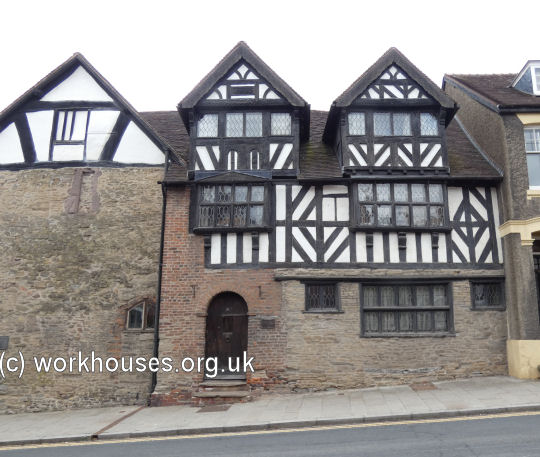
Lane's House, Ludlow, 2020.
© Peter Higginbotham.
A house at the southern end of Leintwardine once served as the parish poorhouse.
After 1834
The Ludlow Poor Law Union formally came into being on 15th July 1836. Its operation was overseen by an elected Board of Guardians, 38 in number, representing its 32 constituent parishes as listed below (figures in brackets indicate numbers of Guardians if more than one):
County of Salop:
Abdon, Ashford Bowdler, Ashford Carbonell, Bitterley (2), Bromfield, Caynham, Clee St Margaret, Cold Weston, Culmington, Diddlebury, Halford, Holdgate, Hope Bagot, Hopton Cangeford, Ludlow (5), Munslow, Onibury, Richard's Castle (part of), Stanton Lacy (2), Stoke St Heath, Stoke St Milborough, Stokesay, Tugford.
County of Hereford: Aston or Pipe Aston, Burrington, Downton, Elton, Leinthall Starkes, Leintwardine North Side, Richard's Castle (part of), Wigmore.
Counties of Salop and Hereford: Ludford.
Later Additions: East Hamlet (from 1884), Ludlow Castle (1862-1901).
The population falling within the union at the 1831 census had been 17,476 with parishes ranging in size from Cold Weston (population 25) to the Ludlow itself (5,252). The average annual poor-rate expenditure for the period 1833-35 had been £6,972 or 8s.0d. per head of the population.
Initially, it seems that the Ludlow Guardians were considering a plan for the conversion of the Leintwardine parish poorhouse into a workhouse for the union. However, a new union workhouse was built in 1836 at the junction of New Road and Gravel Hill in Ludlow. The Poor Law Commissioners authorised an expenditure of £5,000 on construction of the building which was to accommodate 250 inmates. The architect was Matthew Stead and his design was based on the model cruciform or "square" plan published by the Commissioners in 1835. The workhouse location and layout are shown on the 1901 map below.
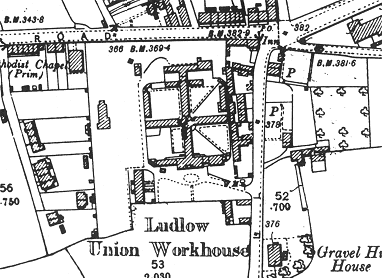
Ludlow workhouse site, 1901
An entrance and administrative block lay at the south, behind which four accommodation ranges radiated from a central hub. Between the arms of the cross, separate exercise yards were created for the various classes inmates (infirm/able-bodied, male/female, etc.) with the north-east and south-east yards being divided by diagonal walls.
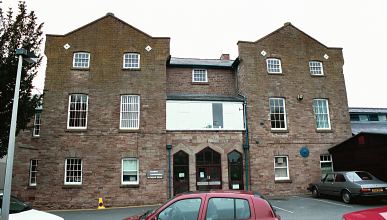
Ludlow entrance block from the south, 2001.
© Peter Higginbotham.
A casual ward was erected at the east of the entrance block.
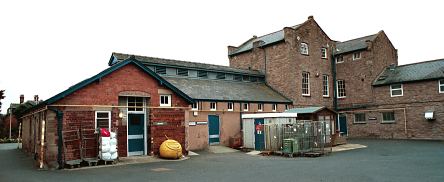
Ludlow casual ward and rear of main block from the north-east, 2001.
© Peter Higginbotham.
A separate building at the south-west of the workhouse may have been a school block.
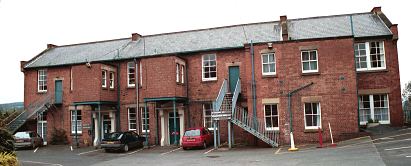
Ludlow school(?) block from the east, 2001.
© Peter Higginbotham.
After 1930, the workhouse became a Public Assistance Institution then, in 1948, joined the National Health Service as East Hamlet Hospital. The surviving buildings now form part of Ludlow Hospital.
Staff
Inmates
Records
Note: many repositories impose a closure period of up to 100 years for records identifying individuals. Before travelling a long distance, always check that the records you want to consult will be available.
- Shropshire Archives, Castle Gates, Shrewsbury, Shropshire SY1 2AQ. Please note that records may contain gaps or have access restrictions - please check before visiting. Holdings include Guardians' minute books (1836-92, 1896-1930); Admissions and discharges (1846-81, 1890-94, 1900-08, 1911-13); Births (1836-1944); Deaths (1837-66); Creed register (1869-1906); Punishment book (1842-1912).
Bibliography
- Williams, Derek (2012) The Story of Ludlow Workhouse
Links
- None.
Unless otherwise indicated, this page () is copyright Peter Higginbotham. Contents may not be reproduced without permission.


